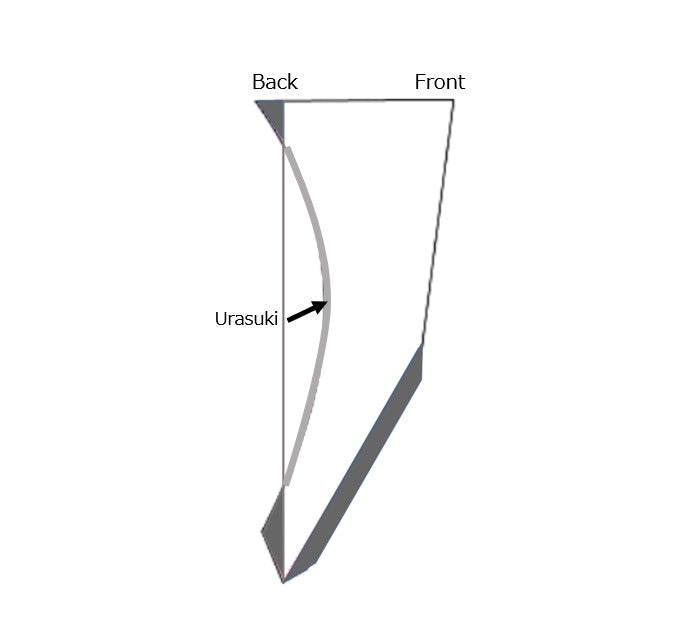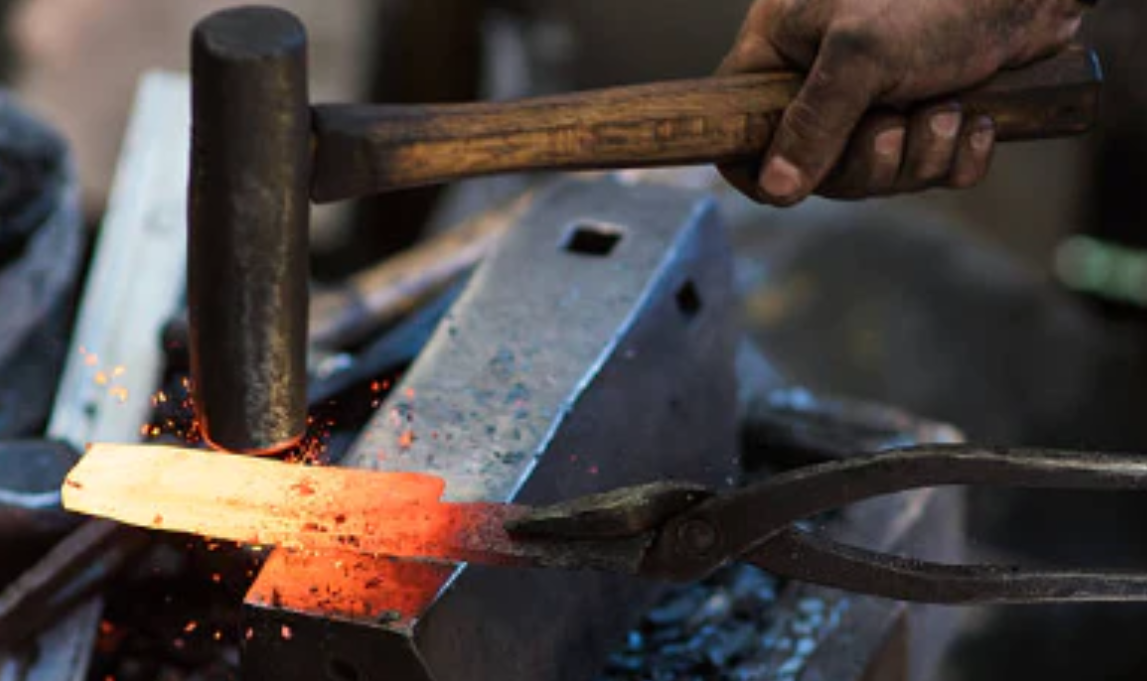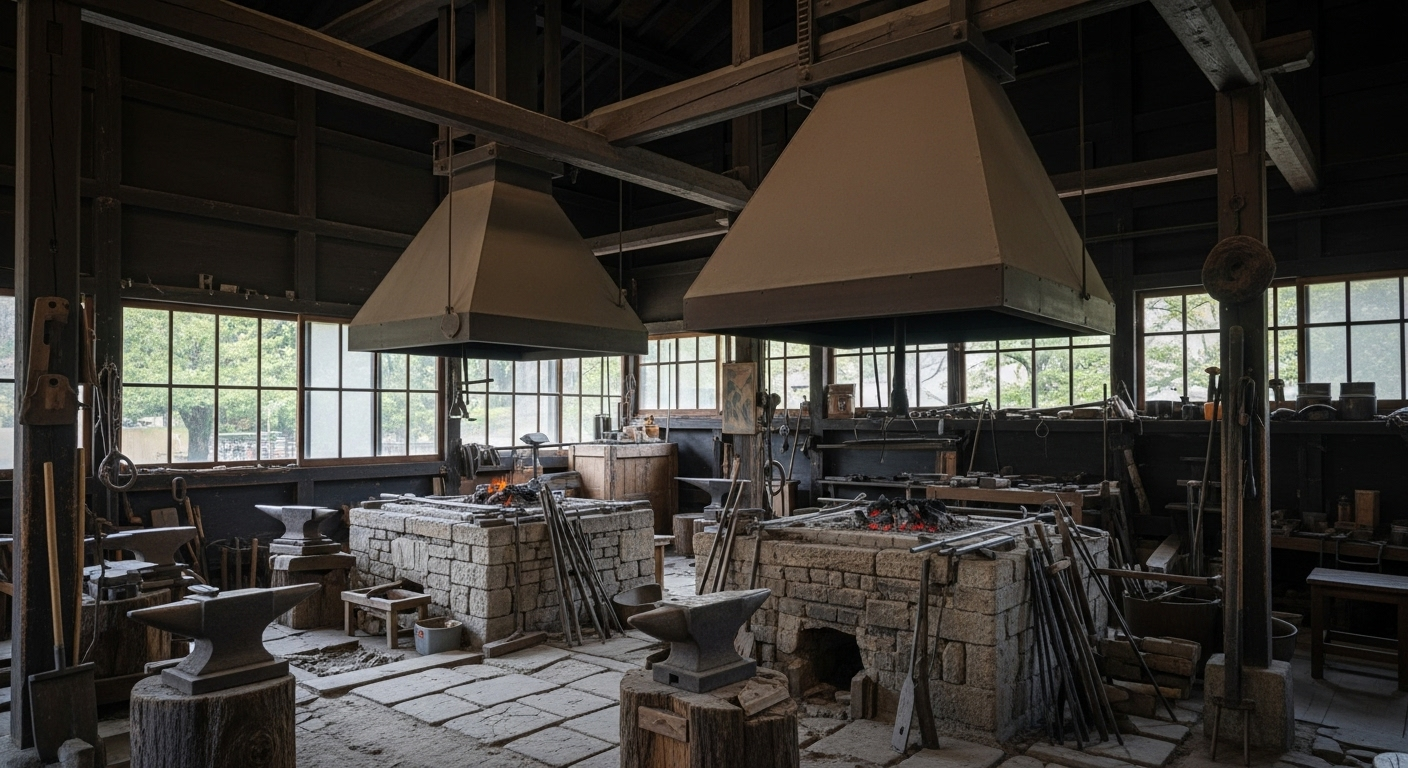
日本刀结构
-
单刃刀与双刃刀:工艺与功能的结合
每把刀都讲述着一个故事——关于文化、工艺和美食。在本视频中,我们将探讨日式单刃刀和西式双刃刀之间的主要区别,以及每种设计如何体现独特的烹饪哲学。
-
1. 单刃刀 vs. 双刃刀:工艺与功能的结合
-
在世界各地的厨房中,形成了两种截然不同的刀具哲学——日式单刃刀的精致精准,以及西方双刃刀的实用多功能性。它们的差异不仅仅在于设计,更体现了人们对食物、技术和工艺的根深蒂固的价值观。
-

-
1-1. 单刃刀:源自日本传统的精准 -

Japanese single-edge knives are celebrated for their elegance and exacting craftsmanship. As the name implies, only one side of the blade is sharpened, creating a uniquely refined geometry defined by the ridge line known as the Shinogi.

单刃刀有何独特之处?
与双刃刀不同,单刃刀的刀刃是不对称的。正面(右侧)被磨成锐角,而背面则有一个微妙的凹陷——称为“Urasuki ”——这提高了切割精度,并使食物与刀刃平滑分离。
得益于这种设计,刀片逐渐变细,刀刃极其纤薄锋利。切割过程中,会形成一个小气穴,帮助食材轻松地从刀上滑落。
-
优点
-
卓越的锋利度
超薄刀刃可在切食材时阻力极小,实现干净利落的切割,不会压碎纤维 - 非常适合切生鱼片或精致的蔬菜。 -
简化锐化
仅一侧需要磨锐,从而实现更一致的角度并且更易于维护。 -
目标驱动设计
每把刀都有明确的作用:出刃用于切鱼,柳刃用于切生鱼片,薄刃用于切蔬菜。
-
卓越的锋利度
-
缺点
-
需要熟练的技术
这种不对称意味着掌握直线切割需要练习。正确的握刀方式和对刀刃曲线的感知至关重要。 -
左撇子用户受限
标准的单刃刀是为右手使用者制作的;左手版本必须定制或专门采购。
-
需要熟练的技术
-
1-2. 双刃刀:西方实用性与平衡性
-
双刃刀的两面均对称磨砺,形成均衡的结构,适合各种切割风格。如今,三德刀和牛刀等热门刀型已成为西方和日本家庭的必备之物。
-

优势
-
能很好地处理坚硬的食物
两侧均匀的压力可为南瓜或土豆等致密的食材提供稳定性。 -
双手通用
对称的形状对于惯用右手和左手的用户来说同样适用。 -
多用途实用程序
一把刀可以处理肉类、鱼类和蔬菜——非常适合快节奏的日常烹饪。
-
能很好地处理坚硬的食物
-
缺点
-
不太适合薄片
双斜面刀刃使得切出生鱼片所需的超薄切片变得更加困难。 -
磨砺需要实践
磨刀时保持对称性需要精确控制两侧的角度——这对初学者来说比较困难。
-
不太适合薄片
-

-
2. 东西方的切割哲学:刀锋背后的文化
-
在每一种文化中,我们切食材的方式不仅仅反映出技术,还揭示了我们如何看待食物本身的哲学。
-

拉切之美:日式方法
日式料理注重食材的新鲜度和自然状态。刀不仅仅是一种工具,更是一把展现食物内在美的画笔。
最受推崇的技艺之一是“拉切”( hiki-giri ),用柳刃刀进行。刀刃连续划动,滑过细嫩的鱼肉,保留鱼肉纤维,使鱼肉表面光洁如镜。这种方法不仅注重效率,更注重尊重食材的完整性,尽可能地将其纯粹而精美地呈现。在像生鱼片这样的菜肴中,切法本身就决定了用餐体验。
-

对比理念:西方烹饪的变革
在西方烹饪中,食材同样重要,但其理念往往强调通过烹饪和酱汁进行转化。刀是一种多功能工具,可以高效地处理蔬菜、肉类和香草,然后再通过加热、调味和酱汁使其更加美味。
双刃刀刃,对称且用途广泛,正是这种理念的体现。它的实用性使厨师能够快速直观地在不同任务之间切换,从而支持风味、质地和酱汁之间的创造性互动,这正是西方烹饪的精髓所在。
-
选择适合当下的刀具
两种传统都有其优势,而艺术在于在正确的时刻选择正确的刀具。
-
当单刃刀闪耀光芒时:
- 制作生鱼片或注重视觉吸引力的菜肴
- 装饰性蔬菜切片或精确装饰
- 切鱼片或需要技术技巧的任务
-
双刃刀的优势:
- 每天准备各种食材
- 快速、高效地切片、切碎和切块
- 适合所有技能水平的烹饪程序,从初学者到专业人士
-
文化遗产在你手中
日本单刃刀不仅仅是锋利的钢材——它们是经过数百年传统和精湛工艺打造的精密艺术品。
西式双刃刀代表着创新和适应性,专为提高现代厨房的效率而设计。在当今的全球烹饪界,了解这两种传统使我们能够有目的性和艺术性地烹饪。
您对刀具的选择体现了您的烹饪理念——无论是倾向于保留自然纯净,还是通过创意改变风味。我们兼收并蓄,在每一刀的烹饪中,传承东西方智慧。
-

-
3. Understanding Japanese Knife Craftsmanship: Craft, Structure, and Tradition
-
说到日本刀,其差异远不止刀刃而已。
材料的选择、锻造方法以及每把刀片背后的哲学都体现了几个世纪的传统。
对于任何热爱烹饪的人来说,了解这些区别是欣赏日本刀具真正艺术性的关键。 -
3-1. 单刃刀:Honyaki 对比 Kasumi
-
-
本烧:纯钢,精准
本烧刀由一整块高碳钢锻造而成,是日本锻造工艺的极致体现,直接源自武士刀制造工艺。
它们具有出色的硬度、保持极薄边缘的能力以及无与伦比的切割体验。然而,这种完美也伴随着挑战。它们极高的硬度使得打磨十分困难,需要合适的磨刀石和精湛的技艺。它们也更脆,需要小心处理。而且,由于锻造工艺极其复杂,最终成品的差异很大程度上取决于工匠的技艺。
-
Kasumi(Awase):实用和谐
相比之下,Kasumi 刀具采用硬钢芯与软铁层压而成,在锋利度和易用性之间实现了完美的平衡。它们更容易打磨,日常使用也更具韧性,适合专业人士和家庭烹饪爱好者。
权衡利弊:不同金属之间的结合有时会导致变形,而且其长期性能很大程度上取决于锻造的质量。然而,一把精心制作的 Kasumi 刀却完美地融合了传统与便捷。
-

3-2.双刃刀:Zenkou vs. Kasumi Hari Awase
-
Zenkou(全钢):耐用且稳定
Zenkou 刀具由一整块钢材锻造而成,因其强度高、刀刃保持力强和性能稳定而备受推崇。由于刀刃经过整体硬化处理,即使长时间使用也能保持锋利,不易崩刃,是追求可靠性的专业人士的可靠之选。
然而,同样均匀的硬度意味着与层压刀相比,磨刀需要更多时间和精力。由于没有 Kasumi 结构中较软的层,磨刀石只能研磨硬钢,这需要耐心和技巧。从结构上讲,可以将 Zenkou 刀重塑为单斜面刀刃,但实际上这种情况并不常见,通常也不推荐,因为这类刀的设计旨在实现双刃平衡。 -
Kasumi Hari Awase:层层工艺
Kasumi 刀具采用坚硬的钢芯和较软的外层层压而成。这在锋利度、减震性和易磨性之间达到了完美的平衡。较软的外层使维护更加便捷,即使是经验丰富的家庭厨师也能轻松恢复锋利。
缺点是,外层在频繁使用下可能会略微变形,而且与全光刀相比,刀刃的保持时间通常较短。此外,由于采用双斜面设计,它们无法复制传统单斜面日本刀的专业精度。 -
共同的遗产
Zenkou 和 Kasumi Hari Awase 都代表着对同一挑战的不同解答:如何兼顾锋利、耐用和易用。无论您选择全钢结构的韧性,还是层压板的实用性,每把刀都体现了数百年来日本的工艺以及烹饪本身背后的文化价值。
-

关于单刃刀和双刃刀的常见问题解答

Q1. 单刃刀和双刃刀有什么区别?
单刃刀仅一面锋利,另一面平整或略微凹陷。这种传统的日式设计能够实现无与伦比的精准度,并带来流畅、干净的切割效果。相比之下,双刃刀的两面对称锋利。这种西式几何形状使其用途更广泛,适用于各种食材和烹饪风格。
Q2. 日本为何会进化出单刃刀?
单刃刀的演变反映了日本对烹饪精致和精准的重视。它们尤其适用于烹制鱼类,完美的切割能够保留鱼肉的质感、鲜味和视觉吸引力。日本的制刀传统也对这些刀刃的工艺和几何形状产生了影响。
Q3. 哪种类型适合初学者?
双刃刀通常更适合初学者。对称的刀刃使其更容易磨利,使用起来更直观,并且适用于各种菜系。双刃刀也同样适合惯用左手和右手的使用者,而且通常比手工制作的单刃刀更实惠。
Q4. 单刃刀和双刃刀的切割技术有什么不同吗?
是的。单刃刀强调拉切( hiki-giri ),使用平滑、可控的划动,最大限度地减少对纤细纤维的损伤。双刃刀则支持更广泛的技巧,包括推切和摇动动作,适合处理各种食材和西式烹饪。
Q5. 左撇子可以使用单刃刀吗?
当然,这并非没有经过修改。标准单刃刀专为惯用右手的厨师设计。对于惯用左手的厨师,则需要采用反向刀片几何形状的特殊版本,以确保同样的精准度和控制力。
Q6. 专业厨师喜欢哪种类型?
这取决于菜系。在传统的日式厨房中,单刃刀仍然是制作生鱼片和怀石料理等精细任务的必备刀具。在西式或融合式厨房中,双刃刀因其多功能性和快速性而备受青睐。许多厨师同时拥有两种刀型,根据不同的情况选择合适的刀具。

一、日本刀为什么是单刃的?
-
在日本,刀片从来不仅仅是一种工具。
它体现了历史、骄傲和对完美的追求。
而这种传统在日本单刃刀的设计中体现得最为明显。为什么要这样制作?
答案不仅仅在于技术,还在于数百年的传统、和平和工艺。 -

(1)刀刃并非仅仅用于战斗
在日本,刀片一直不仅仅是武器。
它们被视为骄傲、美丽和技术精湛的象征。这个故事中的一个关键人物是后鸟羽天皇,他出生于 1180 年日本镰仓时代。
他三岁时就当上了皇帝,后来以隐居皇帝的身份统治国家。但 Go-Toba 并不是一个普通的统治者——他对刀刃有着深厚的热情。
他支持日本各地的刀剑锻造师,甚至亲自参与锻造刀剑。这种对刀具的深厚文化尊重成为了日本身份的一部分,并最终塑造了当今日本厨房使用的刀具。
-

(2)和平完善了刀刃
江户时代,日本经历了260多年的和平。
由于没有战争,铸刀匠将注意力从武器转向日常生活工具——最重要的是菜刀。与此同时,厨师们将烹饪提升为一种精致和呈现的艺术形式。
这种宁静的环境培育了要求食物烹饪精准、美观的文化价值观。正是在这样的背景下,单刃刀应运而生,完美地满足了日本料理的需求。
-

-
(3)转折点——从剑到刀
1876 年颁布了《废刀令》 ,禁止在公共场合携带刀剑。
许多铸剑师失去了生计,但并未失去技艺。他们将工艺转向厨刀制造,将堺市和关市等城镇变成了全球刀具制造中心。
曾经用于武士刀的技术如今在日本餐桌刀上得以延续。 -
为什么是单刃剑?
原因在于历史:漫长的和平时代、将食物提升为艺术的文化、以及将刀剑技艺运用到烹饪中的工匠。
最终的结果是,刀片具有无与伦比的美观和精度。单刃刀可以让厨师:
- 精准地将鱼肉从鱼骨中分离出来
- 沿着天然纤维切片,不要破坏纹理
- 保留风味和外观,保持菜肴的纯净和优雅
在日本,食物被视为文化和美学的表达,单刃刀不仅仅是实用的。
它变得至关重要。 -

一把反映一个国家的刀
日本刀不仅仅是一种厨房用具。
它是历史、和平、工艺和文化自豪感的产物。每一刀都讲述着一个故事——关于皇帝和铸剑师、和平的世纪以及对完美的追求。
单刃刀片不仅仅是一种技术选择。
它是日本文化灵魂的体现。 -
刀的灵魂:日本刀的文化史 -

日本刀具的历史传承与天皇、和平以及刀匠息息相关。
它们的单刃设计体现了对精准的文化追求,将切割食物视为一种艺术。
二、你的刀是“万能伙伴”还是“专业工匠”?
-
拿起你厨房里的刀。它是一把“可靠的全能刀”,一把刀就能处理各种食材?还是一把专为特定任务设计的“专业刀”?
这种差异,暴露了日本刀具与西方刀具在设计理念上的根本差距。
-

-
日本刀:“追求完美”的工匠世界
日本刀的目标
日本刀继承了日本刀剑技法,并专门为鱼类和蔬菜的烹饪而演变。由于日本料理注重不压碎食物细胞,并创造美观的横截面,因此刀具要求极致的锋利和精致。
-
日本刀的特点:
- 单刃结构:与食材分离良好,切口美观
- 专门用途:为特定目的而进化,例如柳刃(用于生鱼片)、出刃(用于鱼类)和薄刃(用于蔬菜)
- 极致锋利:锋利的刀刃不会压碎食物细胞
- 插入式手柄:可持续设计,手柄腐烂后可更换
-
“磨砺文化”的美学
日本人有“爱刀如剑”的文化。他们定期磨刀以保持锋利,一把刀几十年如一日地使用。这超越了对工具的执着——这是一种独特的日本美学。
-
- 烹饪艺术:最大限度地展现食材的美感和风味
- 食材是主角:尤其是在生鱼片中,刀的锋利程度会影响味道
- 精细技术:精确切割,不会破碎食物细胞
-
西式刀具:源于“追求效率”的普遍实用性
西方刀具的目标
明治时代以后,西洋刀从西方传入日本,在肉食文化的背景下发展起来。西洋料理注重大胆地切割带骨的肉,并在炖菜中动态地处理肉类,因此刀具需要耐用性和多功能性。
-
西洋刀的特点:
- 双刃结构:对称设计,任何人都可以轻松操作
- 一刀多用:用一个刀片即可处理肉类、鱼类和蔬菜
- 坚固的结构:强度和耐用性,可切开带骨的肉
- 手柄结构:坚固的结构,刀片的核心材料夹在手柄中并用铆钉固定
-
“实用至上”的理性设计
西方刀具文化历来强调“效率和实用” 。当刀刃磨损时,人们倾向于更换新刀,而不是重新磨刀。这是注重时间效率的理性选择,而非对质量的漠视。
-
- 烹饪作为手段:快速有效地制作营养餐
- 通过调味完成:用酱汁和香料进行最终的味道调整
- 强力烹饪:即使带骨肉也能大胆加工的实用性
-

-
现代影响:融合与进化
有趣的是,如今日本家庭中最常用的三德刀其实是一种西式刀。这是将牛刀(厨师刀)与日本刀技术融合而产生的独特的日本演变。
此外,还有双刃日本刀(如菜刀)和日本制造的西洋刀(日本三德刀、日本牛刀、日本小刀),使得界限变得复杂且交织在一起。
-
一把刀蕴含的世界观
当你握住一把日本刀时,你握住的是“千年工艺与审美的结晶”。这是一件艺术品,蕴含着对食材的尊重,以及对完美切割的追求。
当你握着一把西式刀时,你握着的是一件“高效实用的万能工具”。它是完美契合现代生活方式的可靠伙伴。
-
你的烹饪风格是什么?
- 追求素材之美,注重锋利度→日本刀专业化
- 节省时间,注重效率,想用一把刀搞定一切 →西式刀的多功能性
- 想要两全其美→日本制造的西式刀具也是不错的选择
-
双刃刀之争:单刃刀与双刃刀的选择 -

单刃刀和双刃刀体现了两种不同的烹饪理念。
一种人崇尚精准和精湛技艺;另一种人则推崇多功能和便捷性。
正确的选择是握感自然、能让你在日常烹饪中感受到乐趣的刀具。
三、日本刀的神秘技术:
-
日本刀具深受世界各地厨师的青睐。其锋利无比的背后,蕴含着三个历经数百年精雕细琢的精密技术。这些超越单纯烹饪工具、堪称艺术品的日本刀具,俘获了全球烹饪专业人士的心。究竟是什么让它们如此令人着迷呢?
-
柱子
日本刀的特别技术:源自工匠智慧的三大创新
-
(1)锥度:通过细微的厚度变化来控制摩擦
-
角度的秘密
日本刀的刀刃从刀根到刀尖的角度有微妙的变化。这种“扭曲”技术可以根据特定用途实现最佳的锋利度。
-
-
柱子
磨砺的重要性
保持这些角度变化对于保持刀具性能至关重要。如果没有正确的磨刀技巧,这种精密设计就失去了意义。
-
凹面结构带来非凡的锐度
单刃刀背面采用的“urasuki”凹面结构是日本刀具的标志性技术。这种设计最大限度地减少了刀刃与食物的接触面积,从而达到极致锋利的效果。
-
(3)Urasuki:日本刀的标志
-
urasuki刀最显著的特征或许是刀背的凹形设计。这减少了刀刃与食物的接触面,使其格外锋利。
- 最小摩擦:只有小面积接触食物
- 风味保护:对于生鱼片来说尤其重要,可以保留鲜味
- 点接触切割:创造刀片精确滑动的理想状态
制作 urasuki 刀需要非凡的技艺和经验。刀刃过宽会削弱刀刃,过窄则会降低刀效。这项技艺只有技艺精湛的工匠才能传承下来。 -
-
柱子
对原料的至高尊重
日本料理的根本理念是“最大限度地展现食材的美感” ,这催生了这些精密的技术。新鲜的鱼生鱼片、时令蔬菜的薄片——在这些菜肴中,切面本身的美感也成为了美味的一部分。
-

-
柱子
如今,专攻法国和意大利料理的厨师们也对日本刀具着迷。这是因为这些技术带来的锋利感,具有超越烹饪流派的普遍价值。
尊重食材,追求精湛技艺,追求美的享受——这些是世界各地厨师共同拥有的价值观。日本刀的精密技术正是实现这些烹饪理念的终极工具,并持续受到世界各地厨师的喜爱。
世界各地的厨师们,请至少尝试一下日本刀。它非凡的锋利度必将为您的烹饪带来全新的维度。结合科技中蕴含的日本精神,何不拓展您烹饪的可能性?
日本刀具的三种精密结构——锥形、扭曲和 urasuki——不仅仅代表着技术成就,更体现了数百年来文化的精湛传承以及对烹饪完美的不懈追求,这正是日本工艺的精髓所在。在这个美食无国界的世界里,这些刀具以其卓越的性能,如同沟通不同烹饪传统的桥梁,成为沟通的桥梁。
四、本烧刀与全钢刀的区别
-
-
由一整块硬钢制成的刀具有两种不同的类型:本烧和全钢。了解这些差异对于选择刀具至关重要。
-
柱子
首先,本烧是指通过锻造制作而成的刀具,锻造是一种细致的工艺,需要反复捶打和塑形钢材。这种方法让人想起传统的日本制刀工艺,工匠们用他们的技能手工制作每一把刀。锻造包括加热金属并用锤子塑形、调整内部晶体结构并进行压缩。这一工艺使刀刃具有出色的耐用性和韧性,这对于承受冲击和压力至关重要。以这种方式锻造的本烧刀具有非凡的硬度和锋利度,即使是薄刀片也能轻松切割食物。其精准度可确保刀刃长时间保持锋利,最大限度地减少频繁磨刀的需要。这是本烧刀具工艺的精髓。
-

柱子
本烧刀不仅仅是一种工具,更是凝聚了工匠的技巧和热情的艺术品。刀刃滑过食材的感觉、精准切割的美感以及持久的锋利度,都为人们带来无与伦比的体验。对于那些重视烹饪艺术的人来说,本烧刀可以提升食物的准备和呈现,使其成为专业人士和爱好者的首选。
-

柱子
相比之下,全钢刀由一块钢制成,仅使用模具成型。这些刀缺少锻造过程,导致内部结构不够精致,与本烧刀相比耐用性和韧性较低。但是,全钢刀性价比高,适合日常使用。
-
本烧刀具采用特殊技术和工艺,具有无与伦比的美观和性能。对于那些寻求优质刀具的人来说,本烧提供了与众不同的卓越选择。
-
本烧对战前光:同一块钢铁的两种命运 -

本烧和前光都是用同样的钢材制成,但它们所采用的工艺却造就了完全不同的工具。
本烧被锻造成一件精美的杰作,而前光则被塑造成一把易于使用、实用的刀刃。
这种差异不仅体现在技术上,更体现在对刀具应有的理念上。





















